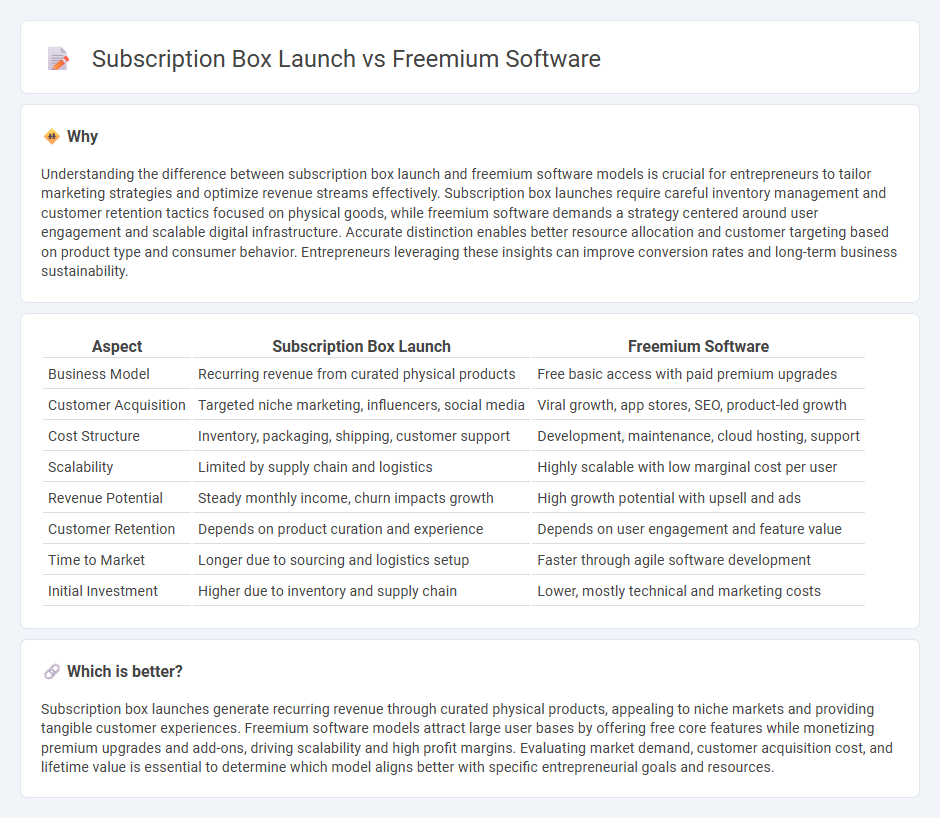
Subscription box launches capitalize on tangible product delivery, offering curated experiences that foster customer loyalty and recurring revenue through physical goods. Freemium software models attract users with free access to basic features, converting a percentage into paying customers seeking enhanced functionality or premium services. Explore these strategies in depth to determine the best entrepreneurial approach for your market.
Why it is important
Understanding the difference between subscription box launch and freemium software models is crucial for entrepreneurs to tailor marketing strategies and optimize revenue streams effectively. Subscription box launches require careful inventory management and customer retention tactics focused on physical goods, while freemium software demands a strategy centered around user engagement and scalable digital infrastructure. Accurate distinction enables better resource allocation and customer targeting based on product type and consumer behavior. Entrepreneurs leveraging these insights can improve conversion rates and long-term business sustainability.
Comparison Table
| Aspect | Subscription Box Launch | Freemium Software |
|---|---|---|
| Business Model | Recurring revenue from curated physical products | Free basic access with paid premium upgrades |
| Customer Acquisition | Targeted niche marketing, influencers, social media | Viral growth, app stores, SEO, product-led growth |
| Cost Structure | Inventory, packaging, shipping, customer support | Development, maintenance, cloud hosting, support |
| Scalability | Limited by supply chain and logistics | Highly scalable with low marginal cost per user |
| Revenue Potential | Steady monthly income, churn impacts growth | High growth potential with upsell and ads |
| Customer Retention | Depends on product curation and experience | Depends on user engagement and feature value |
| Time to Market | Longer due to sourcing and logistics setup | Faster through agile software development |
| Initial Investment | Higher due to inventory and supply chain | Lower, mostly technical and marketing costs |
Which is better?
Subscription box launches generate recurring revenue through curated physical products, appealing to niche markets and providing tangible customer experiences. Freemium software models attract large user bases by offering free core features while monetizing premium upgrades and add-ons, driving scalability and high profit margins. Evaluating market demand, customer acquisition cost, and lifetime value is essential to determine which model aligns better with specific entrepreneurial goals and resources.
Connection
Subscription box launches and freemium software models both leverage customer acquisition strategies focused on low entry barriers and recurring revenue streams. Subscription boxes use curated product samples to attract initial users, while freemium software offers basic functionality for free to encourage upselling to premium tiers. Both methods maximize user engagement and lifetime value by combining trial experiences with scalable subscription payments.
Key Terms
Customer Acquisition
Freemium software models attract customers by offering a free-tier product that encourages user engagement and upgrades through added features or enhanced performance, maximizing organic growth and reducing initial acquisition costs. Subscription box launches rely heavily on targeted marketing strategies and irresistible introductory offers to persuade potential customers to commit to recurring purchases, emphasizing retention through curated experiences and personalized value. Explore detailed tactics and case studies to optimize your customer acquisition approach for either model.
Monetization Model
Freemium software monetizes by offering a basic free version to attract users while charging for premium features or upgrades, optimizing revenue through tiered user engagement and in-app purchases. Subscription box launches rely on recurring revenue by providing curated physical products at regular intervals, emphasizing customer retention and lifetime value through personalized experiences. Discover deeper insights into how each model drives sustainable growth and customer loyalty.
Churn Rate
Freemium software models often experience higher churn rates as users can easily switch between free and paid tiers without long-term commitment, creating fluctuations in customer retention metrics. Subscription box launches typically benefit from lower churn rates due to recurring physical product deliveries that enhance customer engagement and perceived value, strengthening subscription continuity. Explore effective strategies to minimize churn rate for both business models and improve customer lifetime value.
Source and External Links
What Is A Freemium SaaS Model ? Everything You Should Know - The freemium software model offers a basic version of the software for free, while charging for premium features or additional capacity; well-known examples include Dropbox, Slack, and Canva, which attract users with a free tier and convert some to paid plans with added functionality.
10 SAAS Companies Who Rocked the Freemium Model - Freemium is a popular SaaS business model where companies provide a free version with limited features or usage, enticing users to upgrade to paid plans for greater capacity or functionality, exemplified by Zapier's limited "zaps" and MailChimp's free email and contact limits.
What is the SaaS Freemium Model? - PayPro Global - The freemium business model benefits both SaaS companies and users by attracting a wider audience with free access to basic software, allowing users to try the product before purchasing premium features, and enabling companies to generate growth and product feedback.
 dowidth.com
dowidth.com